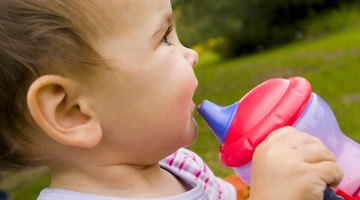How to Prevent Air Bubbles in Baby Bottles
When your baby feeds from a bottle, he's more likely to suck in air than with breastfeeding. If you use a bottle that traps a lot of air inside, your baby may suck in more air than usual. Too much air in your baby's sensitive digestive tract can cause gas, pain and fussiness. If you take steps to reduce the amount of air your baby takes in during feedings, you can greatly increase his comfort and reduce gas-related fussiness, which will make you and your baby happier.
Choose a bottle specially designed to minimize air flow. Try a few different bottles with features such as air-reduction vents or air-minimizing shapes until you find one that works best.
Stir powdered formula when you mix it with water instead of shaking the bottle. Shaking introduces air bubbles into the formula that may not dissipate before your baby drinks the liquid.
Use a bottle designed to hold the amount of formula your baby typically takes in one feeding. Large bottles with small amounts of formula contain more air and increase the likelihood that your baby will suck in that air as he feeds.
Choose a nipple that allows milk to drip at a rate of 1 drop per second when held upside-down, recommends Peace Health Medical Center. These nipples prevent gulping and fast sucking, which can cause your baby to suck in air.
Don't allow your baby to suck on an empty bottle or feed in a bad position where the bottle doesn't supply a steady stream of milk. Tip the bottle upward as it empties to keep milk in constant contact with the nipple opening.











